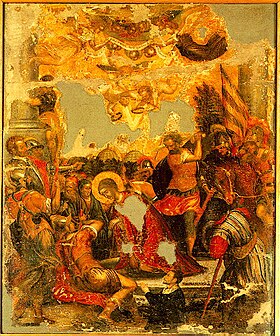Paraskevi of Rome
| Saint Paraskevi of Rome | |
|---|---|

The execution of St. Paraskevi, 16th century. Michael Damaskenos.
|
|
| Martyr | |
| Born | Rome |
| Died | ~170 AD |
| Venerated in | Eastern Orthodox Church |
| Feast | July 26 |
| Patronage | invoked as a healer of the blind; blind people |
Saint Paraskevi of Rome is venerated as a Christian martyr of the 2nd century. According to Christian tradition, she was born in Rome about 140 AD to parents who were Christians. Her parents, Agathon and Politia, were of Greek origin, and had prayed for many years to have a child. When Politia finally bore a child, the baby girl was named Paraskevi, which means “Friday” in Greek (literally "preparation" for the Lord's Day), because she was born on that day. Paraskevi grew up to be a devout and well-read woman, and she rejected many suitors.
At the age of 20, she gave away all of her possessions and became the head of a Christian community of young virgins and widows. She also began to preach the Christian faith, and at the age of 30, left Rome and visited many cities and villages. She was arrested by the Emperor Antoninus Pius, who brought her to trial.
According to tradition, the emperor attempted to force the saint to denounce her faith, and even offered to marry her. Paraskevi refused, and was tortured by having a steel helmet lined with nails placed on her head. Paraskevi endured this torture and her endurance caused many to convert to Christianity. The emperor had the new converts executed. Paraskevi was imprisoned and tortured by being hung by her hair and having her limbs seared with torches. She was also immersed into a large kettle of oil and tar, but she emerged unscathed. When she was accused of using magic, Paraskevi responded by throwing the liquid into the emperor's face. He was blinded, and the emperor begged for mercy. She told him that only the God of the Christians could cure him. Antoninus Pius regained his sight and ended all persecutions against Christians in the empire.
Howevever, after the death of Antoninus Pius, the laws changed once again under Marcus Aurelius, and Paraskevi was imprisoned. She was captured in a city governed by a man named Asclepius, who threw her into a pit with a large snake. The saint made a sign of the cross and the snake was cloven in half. Moved by this miracle, Asclepius then freed her.
In a different city, Paraskevi was imprisoned by an official named Taracius (Tarasios), who placed Paraskevi into a large kettle of oil and tar, but she emerged unscathed, causing there to be new Christian converts. She was then tied and beaten and afterwards a large rock was placed on her chest.
...
Wikipedia
